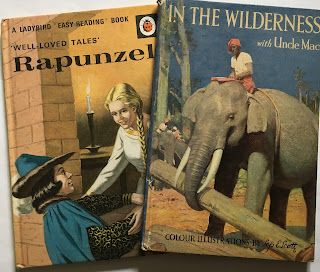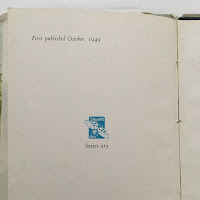There are lots of traps that make the buying and selling of Ladybird books a bit different from other children's books, and which can lead even experienced sellers to describe their wares incorrectly. I'm writing this post from my experience over the years of buying books and talking to sellers. I hope it will help some small-time traders, collectors and charities get it right.
Number 10
Assuming that old Ladybird books are the most valuable.
There are lots of Ladybird book collectors out there - but the vast majority of those who buy have only a mild case of nostalgia and the wish to recapture a bit of childhood (perhaps to share with the next generation or two). The books that seem to have had the biggest impact in this way tend to be fiction rather than non-fiction. Also the non-fiction met the school market -so perhaps there are more around today? Anyway, that's why a beautiful early edition of British Birds and their Nests from 1953 may be much harder to sell than a 1980s reprint of Little Red Riding Hood.
Number 9
Assuming that a loft-find of vintage Ladybird books will make a small fortune.
Between the late 50s and 1980s the company was phenomenally successful - which means that print runs were huge. In turn this means that there are still lots of copies around of most books of this era. The Bible stories of series 522 and 606x, for example, were printed with schools and Sunday Schools in mind, were often given as prizes for good conduct and consequently are often found in large numbers and in pristine condition today. They don't seem to have got much use!
Number 8
Assuming books with an author's signature have been signed by the author
In some series of Ladybird books it was the custom to reproduce the artist's signature on the dust-wrapper or preliminary pages. This was a style feature - not intended to fool anyone. But so often that's what happens. Look out for printed signature on books by:
Gilda Lund
Vesey-Fitzgerald
Max Kester
Auntie Muriel (Muriel Levy)
Number 7
The sticky price label.
Sticky price labels are a massive NO for Ladybird dust-wrappers and matt covers which simply aren't as robust as later laminated covers or later dust-wrappers found on children's books today. Stickers are likely to scar the book.. Light pencil or a post-it-note-type sticker on the preliminaries work best.
Number 6
Assuming misprinted or misbound books are valuable.
Re the massive print-runs mentioned above, lots of mistakes seem to have been made. If you find a misbound book, it may be of mild interest as a curiosity to a collector but more often it will disappoint the buyer. There are lots of such books out there.
(That said, I'm rather fond of this particularly bonkers example and keep it in my collection: it's a mash-up of Peter and Jane, Rapunzel, Arms and Armour)
Number 5
Assuming that any book marked 'First Edition' must be more sought-after. This may well be true if the book is pre-1960s and the information looks like this.
But if the book dates from the 80s or later and the information looks like this: then the words are pretty well meaningless.
Number 4
Apologising for a missing DJ on a vintage Ladybird Book
If the book was first published after 1965 it would never have had a dust wrapper. Nothing to excuse.
But then, conversely ...
Number 4b
Assuming that a book with full-page colour boards never had a dustwrapper.
Some early series books originally had colour boards underneath a dust-wrapper. These series include Uncle Mac, Series 413, series 474 and The Impatient Horse. It's quite simple: any book that was issued before 1964 will originally have had a dust-wrapper.
 |
| This copy of Rapunzel dates from 1968 so never had a dj. In the Wilderness dates from 1948 so it has lots its original dj |
Number 3
Assuming that books with the same name will essentially be the same book.
Even when the book has the same title and is published in the same series, it might be a very different book from the one a buyer is expecting. The safest things is to cite both artist and illustrator (but see Number 1 below). Pictured is an example of the sort or thing that regularly catches buyers out - but there are lots more. More information here.
 |
| Same title, same series - but someone hoping to buy the book on the left would probably be unhappy to receive the one on the right. |
Number 2
Overlooking obvious clues as to the publication date.
Any book with an original price on the back in decimal currency must post-date decimilisation (1971). Any book with a bar code will be from 1982 onwards etc. Why would an experienced seller overlook such obvious clues? Because of 'Number 1' ...
Number 1
Assuming that the date printed in the front of a Ladybird Book is the date it was issued.
 |
| Although this book is dated 1964, it was printed over 12 years later |
Who knows how many buyers have bought books online only to find that a book is a later edition and not the 'first edition' it was described as? Whilst for most books, the latest date mentioned on the preliminary pages indicates the date of that particular edition, this is rarely true for Ladybird Books from the late 1950s onwards. Instead the routine was to put on the title page the date of the first edition, regardless how long ago it was that that first edition appeared; regardless even of the fact that the book might have been revised extensively in the the intervening years.
 |
| Both versions contain only one date: 1962 - but were issued a decade apart |
There are a few more I could add - but 10 is such a neat number. Hope this is some help.




